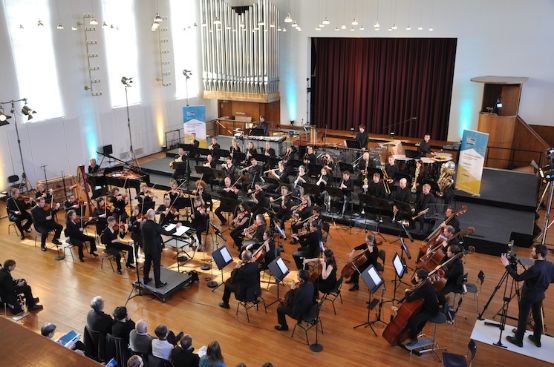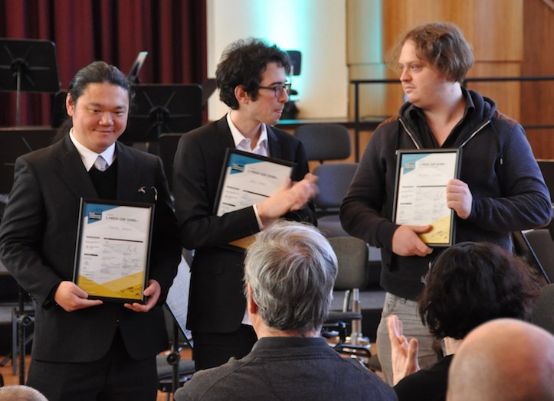Sacher's spirit in the 21st century
The second "Basel Composition Competition" (BCC) took place in the Oekolampad parish hall. - The high quality of the event was once again impressive.

Photo: Niklaus Rüegg
From the outside, the competition has become smaller, but the move from the foyer of Basel's Stadttheater to the comparatively small "Oekolampad" had no impact on the importance of the event. Although the space was a little cramped, especially for the musicians, the proximity to the action was more beneficial for the audience. Thirteen competition entries were to be performed in five concerts from February 20 to 24 - after one competitor withdrew his entry, twelve remained.
With his BCC, organizer Christoph Müller has developed an open format with no age or origin restrictions. A well-functioning sponsorship, or rather a typically Basel, quiet patronage, allows him to charge modest registration fees, to offer high prize money (1st place: 60,000 francs; 2nd place: 25,000; 3rd place: 15,000) and to engage all three Basel professional orchestras. The chamber orchestra, Sinfonietta and symphony orchestra will present the pieces selected for the final, the rehearsal of which - as world premieres - involves some effort. Clear rules apply with regard to the length of the compositions and instruments. A competition entry may not last longer than 20 minutes and the instrumentation depends on the orchestra's resources.
As with the first event in 2017, a youth music education program was attached to the event. A music teacher from Bäumlihof-Gymnasium invited individual composers to the school during the competition week and involved his pupils in the competition activities.
High standards
The attractive constellation of the competition attracted a large number of entries: 450 from 59 countries, with the oldest applicant born in 1929. 250 scores were ultimately submitted, from which the jury members had to select 13. The aim was to make a stylistically broad selection that would be noticeable right through to the final. The jury reflected the high standards of this competition: Michael Jarrell (jury president), Wolfgang Rihm (absent due to illness), Helmut Lachenmann, Magnus Lindberg, Andrea Scartazzini - all internationally renowned composers. In addition, one orchestra representative was present. Felix Meyer represented the Paul Sacher Foundation, which acts as an advisory partner but does not support the event financially. The spirit of Sacher resonates strongly in this project. Christoph Müller makes direct reference to this patron and enabler of contemporary music: "In the spirit of Sacher, the most exciting composers of the 21st century are to be brought to Basel today with the aim of providing inspiration for compositions. In this way, the BCC wants to help build up a repertoire of orchestral works that will still be relevant years from now".
Class final concert
Hosted by Patricia Moreno from SRF 2 Kultur, the final concert was conducted in a relaxed and, in terms of execution, highly concentrated manner. Five works made it to the final. The Basel Chamber Orchestra under the direction of Franck Ollu began with Manuel Martínez Burgos' composition Daivāta Sanskrit word that the composer translated as "time beyond the mind". The audience was treated to a fast, small-scale, expressive piece with martyred brass and a menacing mood. The more accessible work by the Japanese composer Takuya Imahori was quite different Con mille fiori che sbocciano così belliThe Basel Sinfonietta under Baldur Brönnimann musically depicted the blossoming and fading of eleven flowers in sun, wind and weather. Late-romantic moods alternated with spherical, poetic, colorful soundscapes, sometimes leading to a powerful forte: a great success with the audience.
Program items 3 to 5 were all performed by the Basel Symphony Orchestra under Francesc Prat. The program began with the German Benjamin Scheuer, whose piece versed knew how to combine contemporary sounds with wit and humor. He created a highly innovative piece from alienated scraps of music that had been stored in his memory for many years. Grotesquely rippling glissandi lose themselves breathlessly in the void, only to rise up again at breakneck speed. Hissing, chirping and penetrating whistling tones were part of the rich sound material and sometimes mingled threateningly with the listener's tinnitus. In the second part, a somewhat more coherent sound continuum emerged in the dialog between piano and strings.
The Swiss Thomas Mattenberger succeeded with his reductionist Labyrinth rightly until the final five - a real respite between all these intense and richly tonal works: meditative with a small range of intervals, horizontal wind sounds around which orchestral clusters were grouped, signaling tubular bells, hardly any dynamics.
The young Argentinian Alex Nante amazed with a short (one would have liked to listen a little longer) piece with a romantic-impressionistic style called Bright pictureinspired by the painting of the same name by Wassily Kandinsky. The dominant yellow of the painting could be associated with the bright forte passages. They alternated with delicate violin and harp sounds, garnished with clarinets and celesta. At the end, a large sixth stood prominently in the room like a question mark.
The jury's verdict: 1st place Scheuer, 2nd place Nante, 3rd place Imahori.

- Photo: Niklaus Rüegg
From left: Takuya Imahori (3rd), Alex Nante (2nd) Benjamin Scheuer (1st)








